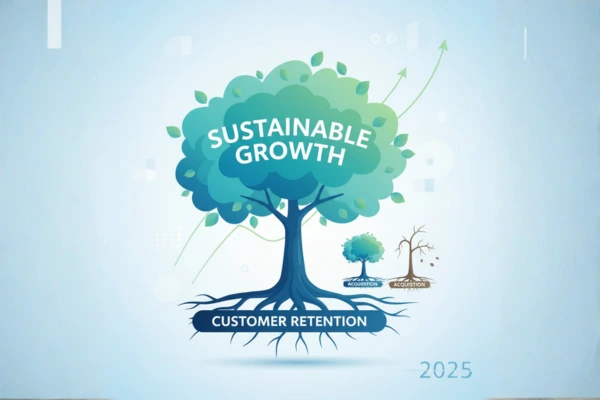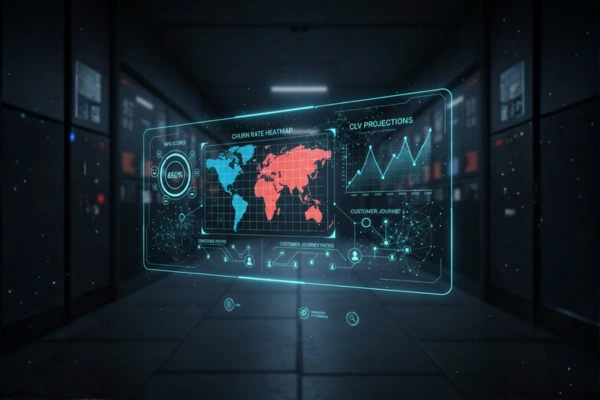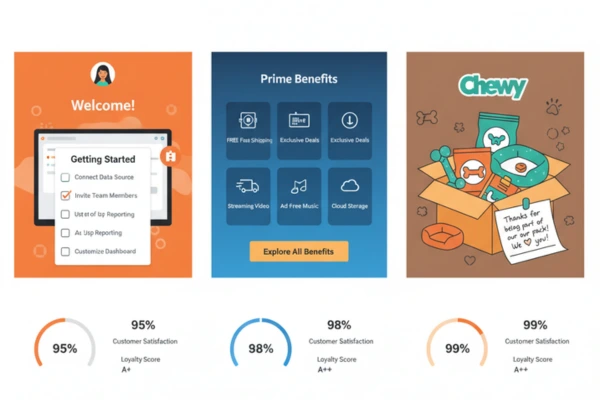Customer Retention Management: 2025 Growth Playbook
Introduction: Why Retention is the New Growth Engine in 2025
In today's hyper-competitive business landscape, acquiring new customers has become increasingly expensive and challenging. While many organizations continue to pour resources into acquisition strategies, the smartest businesses have shifted their focus to what truly drives sustainable growth: customer retention management.

The numbers tell a compelling story: increasing customer retention rates by just 5% can boost profits by 25% to 95% (Harvard Business Review). Yet, despite these staggering statistics, approximately 44% of companies have a greater focus on customer acquisition over retention (Invesp).
This comprehensive playbook will transform how you approach customer relationships. We'll move beyond theoretical concepts to deliver actionable strategies, proven tactics, and real-world examples that will help you build a retention-first organization capable of weathering market shifts and outperforming competitors. Whether you're in SaaS, e-commerce, or professional services, these principles will help you turn one-time buyers into lifelong advocates.
Key Takeaways
- Profit Driver: Focusing on customer retention is more profitable than acquisition, with a 5% increase in retention boosting profits by 25-95%.
- Core Strategies: Effective retention is built on delivering exceptional value, providing proactive customer service, and cultivating genuine relationships.
- Key Metrics: To manage retention, you must measure it. Track metrics like Churn Rate, CLV, and Net Promoter Score (NPS).
Demystifying the Core: What is Customer Retention Management?
Beyond the Buzzword: The True Customer Retention Definition & Meaning
At its core, customer retention refers to a company's ability to retain its customers over a specified period. The customer retention meaning extends far beyond simple repeat purchases—it encompasses the entire lifecycle of strategies, processes, and interactions designed to maintain ongoing customer relationships.
The customer retention definition in business terms is: the set of actions a company takes to reduce customer defections and increase the lifetime value of its customer base. When we examine retention meaning in business, we see it's fundamentally about creating sustainable revenue streams through existing customers rather than constantly chasing new ones.
What does customer retention mean in practical terms? It means:
- Reducing customer churn (the rate at which customers stop doing business with you)
- Increasing customer lifetime value (CLV)
- Building brand loyalty that withstands competitive offers
- Creating predictable revenue streams
Client vs. Customer: Understanding Retention Nuances
While often used interchangeably, client retention and customer retention have important distinctions, especially in B2B contexts:
Customer retention typically applies to B2C relationships with shorter sales cycles, transactional interactions, and lower individual customer value. Strategies often focus on loyalty programs, personalized marketing, and customer service excellence.
Client retention, however, refers to B2B relationships characterized by:
- Longer sales cycles
- Higher-value contracts
- Relationship-based decision making
- Multiple stakeholders within client organizations
- Complex implementation and integration requirements
Account retention specifically deals with maintaining relationships with key business accounts, often requiring dedicated account management teams and customized retention strategies. Understanding these nuances is crucial for developing effective client retention management approaches.
The Critical Link: How Customer Service Fuels Retention
The connection between customer service and retention cannot be overstated. Research shows that 89% of consumers begin doing business with a competitor following a poor customer experience (Qualtrics).
Customer service and customer retention are intrinsically linked through:
- Problem resolution that prevents defection
- Proactive support that anticipates needs
- Personalized interactions that build relationships
- Consistent experiences across all touchpoints
Effective customer service retention strategies include:
- Implementing omnichannel support (phone, email, chat, social media)
- Reducing response and resolution times
- Empowering service representatives to solve problems
- Creating knowledge bases for self-service options
- Following up after resolutions to ensure satisfaction
The Non-Negotiable: Why Retention is Your #1 Profit Lever
Understanding why customer retention is important begins with recognizing the fundamental economics of business growth. While acquisition focuses on filling the top of the funnel, retention plugs the leaks at the bottom, creating a more efficient and sustainable growth model.
Consider these compelling statistics:
- The probability of selling to an existing customer is 60-70%, while the probability of selling to a new prospect is 5-20% (Marketing Metrics)
- Existing customers are 50% more likely to try new products and spend 31% more than new customers (Bain & Company)
- A 10% increase in customer retention levels results in a 30% increase in the value of the company (Bain & Company)
The retention meaning in business extends beyond immediate revenue to include:
- Reduced marketing costs: Retaining customers costs significantly less than acquiring new ones
- Predictable revenue streams: Loyal customers provide stable, recurring revenue
- Enhanced brand reputation: Satisfied customers become brand advocates
- Competitive advantage: Strong retention creates barriers to entry for competitors
- Higher profit margins: Repeat customers typically have lower servicing costs
In essence, retention isn't just a metric—it's the foundation of sustainable business growth in 2025's competitive landscape.
Building the Foundation: Essential Customer Retention Strategies
Strategy 1: Deliver Exceptional Value Beyond the Product
Successful customer retention strategies begin with delivering value that extends beyond the core product or service. This means understanding and addressing the complete customer journey and pain points.
Key components include:
- Continuous innovation: Regularly updating and improving offerings based on customer feedback
- Educational resources: Providing tutorials, webinars, and content that help customers maximize value
- Community building: Creating spaces for customers to connect and share best practices
- Proactive communication: Keeping customers informed about relevant updates and opportunities
When exploring how to improve customer retention, focus on becoming indispensable to your customers' success rather than just selling a product.
Strategy 2: Master Proactive & Personalized Customer Service
Exceptional service is no longer about reactive problem-solving—it's about anticipating needs and delivering personalized experiences at scale. This is particularly crucial for how to retain customers in competitive markets.
Effective customer service retention strategies include:
- Predictive support: Using data analytics to identify and address issues before customers experience them
- Personalization at scale: Leveraging technology to customize interactions based on customer history and preferences
- Empowered representatives: Giving frontline staff the authority and resources to solve problems immediately
- Consistent omnichannel experiences: Ensuring seamless service across all touchpoints
For how to retain clients in B2B contexts, consider dedicated account managers who understand the client's business objectives and can proactively suggest solutions.
Strategy 3: Cultivate Relationships, Not Just Transactions
The most effective client retention strategies focus on building genuine relationships rather than completing transactions. This human-centered approach is fundamental to how to retain customer loyalty.
Relationship-building tactics include:
- Regular check-ins: Meaningful conversations beyond sales pitches
- Personalized recognition: Acknowledging milestones, achievements, and loyalty
- Community engagement: Creating opportunities for customers to connect with each other and your brand
- Transparency and authenticity: Building trust through honest communication and consistent delivery
When implementing customer retention marketing, emphasize relationship-building messages that demonstrate genuine care for customer success rather than purely promotional content.
Actionable Tactics: How to Retain Customers (and Clients) Effectively
Tactic 1: Implement High-Impact Customer Retention Programs
Well-designed customer retention programs create structured incentives for ongoing engagement. These programs should be tailored to your specific business model and customer preferences.
Effective retention program components include:
- Tiered loyalty programs: Offering escalating benefits based on engagement level
- Subscription benefits: Providing exclusive perks for recurring customers
- Referral programs: Rewarding customers for bringing in new business
- VIP experiences: Creating exclusive access or events for top customers
For how to increase customer retention through programs, focus on perceived value rather than just discounts. The most successful programs offer experiences, recognition, and convenience that money can't easily buy elsewhere.
Tactic 2: Leverage Retention Marketing Strategies That Work
Customer retention marketing requires a different approach than acquisition marketing. It focuses on nurturing existing relationships rather than generating new leads.
Key retention marketing strategies include:
- Personalized email campaigns: Triggered communications based on behavior and preferences
- Exclusive content: Providing valuable resources available only to existing customers
- Win-back campaigns: Targeted offers for customers who have reduced engagement
- Cross-sell and upsell initiatives: Recommending relevant additional products or services
When developing customer retention marketing strategies, segment your customer base to deliver relevant messages based on purchase history, engagement level, and lifecycle stage.
Tactic 3: Optimize the Sales Process for Long-Term Success
Sales retention begins with the initial sales process. Setting proper expectations and ensuring a smooth handoff to customer service teams significantly impacts long-term retention.
Sales process optimization includes:
- Aligning sales and customer success: Creating seamless transitions between teams
- Setting realistic expectations: Ensuring customers understand what they're purchasing
- Identifying ideal customers: Focusing acquisition on prospects likely to become long-term customers
- Value-based selling: Emphasizing long-term benefits rather than just features
For how to retain clients in B2B environments, ensure your sales team understands the client's business objectives and can articulate how your solution supports their long-term success.
Tactic 4: Harness Technology: Your Customer Retention System
Modern customer retention systems leverage technology to automate processes, gather insights, and deliver personalized experiences at scale. The right software customer retention solution can transform your retention efforts.

Key technology components include:
- CRM platforms: Centralizing customer data and interaction history
- Analytics tools: Identifying retention trends and at-risk customers
- Marketing automation: Delivering personalized communications based on behavior
- AI-powered insights: Predicting churn risk and recommending retention actions
When implementing a customer retention system, ensure it integrates with your existing technology stack and provides actionable insights rather than just data collection.
Real-World Inspiration: Customer Retention Examples That Deliver
Examining successful customer retention examples provides valuable insights into what works across different industries:

SaaS Example: HubSpot
HubSpot's customer retention strategy focuses on customer education and success. Their inbound marketing methodology provides continuous value through:
- Comprehensive certification programs
- Active community forums
- Regular product updates based on user feedback
- Dedicated customer success managers for enterprise clients
Result: Industry-leading retention rates with 90%+ annual retention for their core products.
E-commerce Example: Amazon Prime
Amazon transformed retail with its retention-focused membership program:
- Free two-day shipping creating convenience
- Prime Video and Music adding entertainment value
- Exclusive deals and early access to promotions
- Personalized recommendations based on purchase history
Result: Prime members spend significantly more than non-members and demonstrate remarkable loyalty.
Service Business Example: Chewy
The pet supply retailer excels at emotional connection:
- Personalized pet portraits in correspondence
- Surprise gifts and handwritten notes
- Proactive customer service including refunding orders without requiring returns
- Donations to animal shelters in customers' names
Result: Exceptional customer loyalty and word-of-mouth marketing.
These customer retention examples demonstrate that successful strategies combine practical value with emotional connection, creating experiences customers won't find elsewhere.
Measuring What Matters: Key Metrics for Retention Success
Effective customer retention management requires tracking the right metrics to understand performance and identify improvement opportunities. Key retention metrics include:
Churn Rate
Definition: The percentage of customers who stop doing business with you in a given period
Calculation: (Customers lost during period ÷ Customers at start of period) × 100
Why it matters: Direct indicator of retention success and revenue stability. Calculate yours with our Churn Rate Calculator.
Customer Lifetime Value (CLV)
Definition: The total revenue a business can expect from a single customer account
Calculation: Average purchase value × Purchase frequency × Customer lifespan
Why it matters: Helps determine how much to invest in retention efforts. Try our CLV Calculator.
Repeat Purchase Rate
Definition: The percentage of customers who make more than one purchase
Calculation: (Number of customers who made multiple purchases ÷ Total customers) × 100
Why it matters: Indicates product/service satisfaction and loyalty
Net Promoter Score (NPS)
Definition: Measures customer willingness to recommend your business
Calculation: % Promoters - % Detractors (based on survey responses)
Why it matters: Correlates strongly with retention and growth
Customer Effort Score (CES)
Definition: Measures how easy it is for customers to do business with you
Calculation: Typically based on survey responses about interaction ease
Why it matters: Lower effort correlates strongly with higher retention
When implementing customer retention programs, establish baseline measurements for these metrics and track changes over time to evaluate effectiveness.
Putting It All Together: Your 2025 Retention Action Plan
Transforming your approach to customer retention management requires a systematic implementation plan. Follow these steps to build your retention-first organization:
- Conduct a Retention Audit: Calculate current retention metrics (churn rate, CLV, NPS). Identify key drop-off points in the customer journey and analyze reasons for customer defections through exit interviews and surveys. Benchmark against industry standards. Use our suite of free calculators to get started.
- Define Retention Goals: Set specific, measurable targets for key metrics (e.g., reduce churn by 15% in 12 months). Establish timelines for achieving goals. Assign ownership for each retention initiative. Align retention goals with overall business objectives.
- Develop Retention Strategies: Select core strategies based on audit findings (value delivery, service excellence, relationship building). Customize approaches for different customer segments. Develop specific tactics for each strategy. Create implementation timeline and resource requirements.
- Implement Retention Systems: Select and configure technology solutions (CRM, marketing automation, analytics). Integrate systems across departments. Train teams on new processes and tools. Establish data collection and reporting protocols.
- Launch and Monitor: Roll out initiatives in phases, starting with highest-impact opportunities. Establish regular monitoring of key metrics. Create feedback loops for continuous improvement. Celebrate early wins to build momentum.
- Optimize and Scale: Analyze results against goals. Refine your approaches based on performance data. Expand successful initiatives across the organization. Institutionalize retention as a core business function.
This structured approach ensures that how to retain customers moves from theoretical discussion to systematic implementation with measurable results.
Conclusion: From Playbook to Profit - Making Retention Your Competitive Advantage
As we've explored throughout this comprehensive guide, customer retention management represents the most significant opportunity for sustainable growth in 2025's competitive business environment. By shifting focus from acquisition to retention, organizations can build more predictable revenue streams, reduce marketing costs, and create lasting competitive advantages.
The key takeaways from this playbook are clear:
- Retention starts with understanding—know your customers' needs, preferences, and pain points
- Value extends beyond the product—deliver experiences, education, and community
- Service is the new marketing—proactive, personalized support prevents defection
- Technology enables scale—leverage data and automation to deliver personalized experiences
- Measurement drives improvement—track the right metrics to optimize performance
The question is no longer why is customer retention important, but rather how quickly you can implement these strategies to transform your business. The organizations that master customer retention management in 2025 will be those that thrive regardless of market conditions, building loyal customer bases that serve as foundations for innovation and growth.
Your next step: Begin with a retention audit to understand your current performance. Identify one high-impact strategy from this playbook to implement in the next 30 days. Remember, retention is a journey, not a destination—but every step you take builds a stronger, more resilient business.
What retention strategy will you implement first? Share your commitment in the comments below, and let's build more customer-centric businesses together.